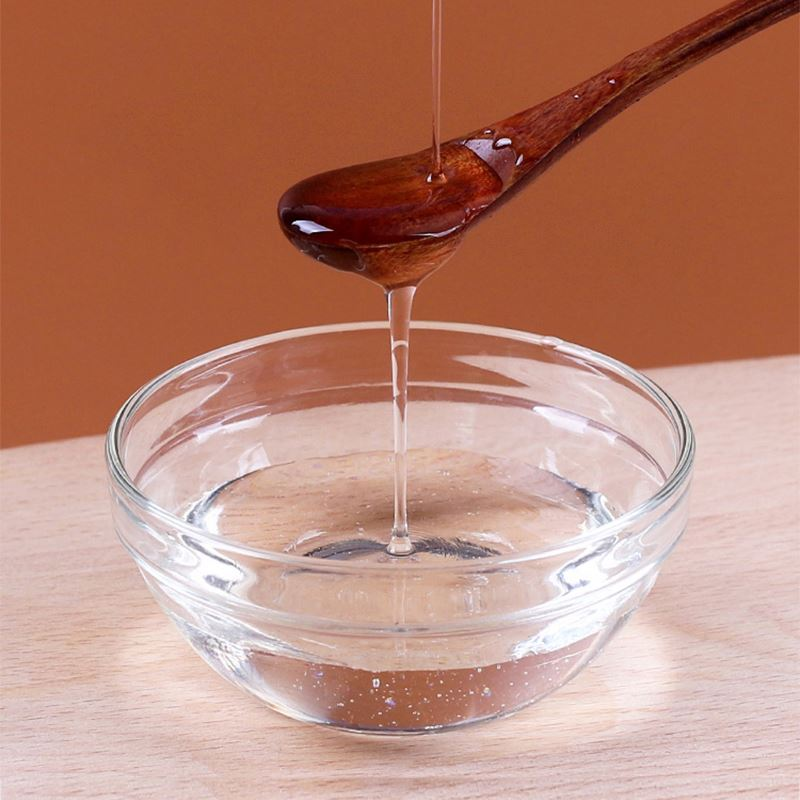Liquid Glucose
Liquid Glucose is commercially called as corn syrup because it’s derived from corn. It is a clear, viscous and yellow coloured solution which does not crystallize. The solids are composed of various carbohydrates such as dextrose, Maltose and higher polysaccharides. Different carbohydrate levels give liquid glucose has some unique application.

- Overview
- Application
- Specification
Overview
Liquid Glucose is commercially called as corn syrup because it’s derived from corn. It is a clear, viscous and yellow coloured solution which does not crystallize. The solids are composed of various carbohydrates such as dextrose, Maltose and higher polysaccharides. Different carbohydrate levels give liquid glucose has some unique application.
General Properties of Liquid Glucose
- Liquid glucose is a viscous light transparency liquid with an appearance of yellowish and transparency color.
- Liquid glucose and sweetness of the liquid glucose depends on the extent to which the hydrolysis of reaction take place.
- Liquid Glucose contains Maltose component to resist against crystallization of the product.
- Liquid glucose is highly hygroscopic with non-crystallizing nature helps the finished products in soft condition.
- Liquid glucose of high dextrose equivalent exhibits moderate osmotic pressure and inhibits microbial spoilage.
- Viscosity of Liquid Glucose is the most important physical Property which depends on the density, Dextrose Equivalent and temperature.
- Liquid glucose can also act as an emulsion stabilizer and freezing point depressant.
- Reducing action of Liquid glucose makes it strong oxidizing agents.
- Liquid glucose has strong fermentability because of its collective properties.
Production of Liquid Glucose
The hydrolysis of starch for the production of liquid glucose can either be acid hydrolysis or enzyme hydrolysis followed by refining and concentration. In the acid hydrolysis process, hydrochloric acid under medium pressure is used, while enzymes are involved in the enzyme hydrolysis process. The source of the starch can be maize (corn), potatoes, wheat, barley, rice, potatoes or cassava. Hydrolysis plant consists of various equipments in hydrolysis plant such as Tubular reactor, Filters, Ion exchange units, Evaporators, Storage tanks, boilers and cooling towers.
Application
Food industry
Liquid glucose is majorly used in food industry as a sweetener, thickener and humectant. It is also widely used in food candy products, soft drinks and fruit drinks. It is primarily used to control sucrose and dextrose crystallization and to bring out the aroma of fruit flavors in confections. Liquid glucose syrup is the primary sweetener used in high fructose corn syrup productions. As a sweetener with high osmotic pressure, it can maintain the flavor and extend the shelf life of preserved fruits, glazed fruits, jams etc.
Pharmaceutical industry
Liquid glucose is used in solid and liquid dosage formulations as a coating agent and it also acts as a granulating agent. It acts as an anti-crystallizing agent and bulking agent in oral solutions and syrups. Liquid Glucose as a liquid is a benefit in the pharmaceutical industry because it is easy to mix into formulations on a large scale. Hence it is used in cough syrups and tonics as the sweetening agent. Liquid glucose can also be used as a medication for diabetic patients with very low blood sugar levels. It’s also useful for the production of artificial honey and Vitamin tonic.
Tanning industry
Liquid glucose is used in tanning industry gives pliability and the weight of the leather. In the chrome process, Glucose syrup is used because of its reducing action.
Other applications
Liquid glucose is used as an effective substitute for sugar. It can also act as a raw material for Gluconic Acid, Kojic Acid, Citric Acid. Liquid Glucose is utilized in curing and imparting flavor in Tobacco. Addition of 5 -10 % of liquid glucose in a shoe polish prevents it from caking and also helps give a better and quick shine. In adhesives, Liquid glucose is used in improving stability of the adhesives. Liquid glucose acts as a setting retardant for the concrete. It is used as a humectants in the air fresheners and as a evaporation control in the perfumes.
Specification
| PRODUCT IDENTIFICATION | |
| CAS NO. | : 8029-43-4 |
| FORMULA | : C6H12O6 |
| MOL WT. | : 180.16 |
| SYNONYMS | : Liquid glucose |
| PHYSICAL AND CHEMICAL PROPERTIES | |
| Moisture Content | : 13-16 %, by weight |
| Total Solids | : 85% min |
| Acidity | : 0.6ml, max |
| pH | : 4.8-5.2 |
| Sulphated Ash | : 0.3% |
| Sulphur Dioxide | : 400 ppm |
| Lead (as Pb) | : 2 ppm, max |
| Arsenic (as As) | : 1.0 ppm, max |
| Copper (as Cu) | : 5 ppm, max |
| Dextrose Equivalent | : 40-45% |
| SALES SPECIFICATION | |
| PHYSICAL STATE | : Colorless Viscous Sweet Syrup |
| ODOUR | : Odourless |
| VAPOUR PRESSURE | : 37-39 mm at 1000 F |
| BOILING POINT | : 2260 F |
| DENSITY | : 11.60 lbs/gal |



